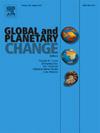中帕拉蒂西海 - 热带东大西洋的一部分,而不是进入印度洋的大门
IF 4
1区 地球科学
Q1 GEOGRAPHY, PHYSICAL
引用次数: 0
摘要
中新世的帕拉特提斯海经常被描绘成原地中海和印度洋的交界处。在此,我们根据其腹足类动物群阐明了中新世这一大型大陆外海的生物地理特征。我们揭穿了一个顽固的神话,即在朗希安时代,这些海域之间通过特提斯海道相连。在中新世早期和中期的大部分时间里,中帕拉泰西海域是通过罗纳海峡和斯洛文尼亚海峡连接起来的,这一点可以从多达 22% 的与原地中海共享的物种中得到佐证。在纬度较高的大西洋东北部,动物区系的相似性依次降低,在北海则降至较低值。因此,在整个中新世早期和中期,可以排除与北海的联系。直到中新世晚期,当东帕拉特提斯海的特有物种 "涌入 "中帕拉特提斯海时,中帕拉特提斯海与东帕拉特提斯海的动物学关系才出人意料地降低。热带东大西洋(TEA)和印度-西太平洋地区(IWP)现今的腹足动物群可通过其不同的动物结构(某些科的相对丰度不同)明显区分开来。帕拉蒂希安海(Paratethyan)和原地中海(Proto-Mediterranean Sea)的动物群更接近于现在热带东大西洋的类型,这表明它们有着共同的起源。在早中新世,通过特提斯海道与印度洋的动物群联系很早就停止了,比 Gomphotherium 陆桥的形成早了几百万年。因此,我们不认为特提斯海道在朗希安时期重新启动会提供一个有效的海洋通道。这对气候模型来说是一个重要的观察结果,它将特提斯海道的关闭与中新世的气候变化联系起来。本文章由计算机程序翻译,如有差异,请以英文原文为准。
The Central Paratethys Sea – Part of the tropical eastern Atlantic rather than gate into the Indian Ocean
The Miocene Paratethys Sea is frequently depicted as junction between the Proto-Mediterranean Sea and the Indian Ocean. Herein, we elucidate the biogeographic character of this large epicontinental Miocene sea based on its speciose gastropod fauna. We debunk the persistent myth that there was a connection between these marine realms during Langhian times via the Tethys Seaway. Throughout most of the Early and Middle Miocene the connectivity of the Central Paratethys was via the Rhône Strait and the Slovenian Strait as supported by up to ∼22 % of species shared with the Proto-Mediterranean Sea. The faunistic similarity decreased successively at higher latitudes towards the northeastern Atlantic and dropped to low values towards the North Sea. Therefore, a connection with the North Sea can be excluded throughout the Early and Middle Miocene. Faunistic relations of the Central Paratethys Sea with the Eastern Paratethys Sea were surprisingly low until the late Middle Miocene, when endemic species from the Eastern Paratethys ‘flooded’ the Central Paratethys. Therefore, the effectiveness in species transfer or presence of the Carasu and Barlad straits, hypothetically connecting both seas, must be questioned for most of the Middle Miocene.
The present-day gastropod faunas of the tropical eastern Atlantic (TEA) and the Indo-West Pacific Region (IWP) can be distinguished clearly by their differing faunal structure (different relative abundance of certain families). The faunas of the Paratethyan and the Proto-Mediterranean Sea follow more closely the type nowadays represented in the tropical eastern Atlantic, suggesting a common origin. The faunistic connectivity with the Indian Ocean, via the Tethys Seaway ceased very early during the Early Miocene, predating the formation of the Gomphotherium land bridge by several million years. Consequently, we reject a re-activation of the Tethys Seaway during the Langhian as providing an effective oceanographic gateway. This is an important observation for climate models, linking the closure of the Tethys Seaway to Miocene climate change.
求助全文
通过发布文献求助,成功后即可免费获取论文全文。
去求助
来源期刊

Global and Planetary Change
地学天文-地球科学综合
CiteScore
7.40
自引率
10.30%
发文量
226
审稿时长
63 days
期刊介绍:
The objective of the journal Global and Planetary Change is to provide a multi-disciplinary overview of the processes taking place in the Earth System and involved in planetary change over time. The journal focuses on records of the past and current state of the earth system, and future scenarios , and their link to global environmental change. Regional or process-oriented studies are welcome if they discuss global implications. Topics include, but are not limited to, changes in the dynamics and composition of the atmosphere, oceans and cryosphere, as well as climate change, sea level variation, observations/modelling of Earth processes from deep to (near-)surface and their coupling, global ecology, biogeography and the resilience/thresholds in ecosystems.
Key criteria for the consideration of manuscripts are (a) the relevance for the global scientific community and/or (b) the wider implications for global scale problems, preferably combined with (c) having a significance beyond a single discipline. A clear focus on key processes associated with planetary scale change is strongly encouraged.
Manuscripts can be submitted as either research contributions or as a review article. Every effort should be made towards the presentation of research outcomes in an understandable way for a broad readership.
 求助内容:
求助内容: 应助结果提醒方式:
应助结果提醒方式:


